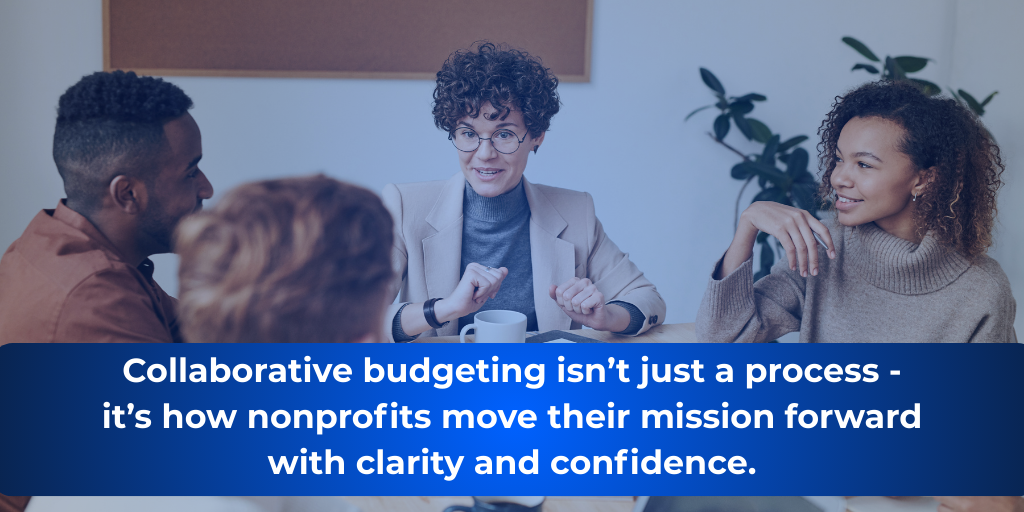The 5 Imperatives of Budgeting, Forecasting, and Reporting
In today’s volatile economic climate, financial clarity isn’t just a competitive advantage—it’s a necessity. Whether you're steering a startup...
3 min read
Martus Solutions : July 09, 2024

Collaborative budgeting is a financial management approach where all relevant stakeholders within an organization participate in the budget creation process. This approach fosters a more inclusive and transparent financial planning environment, ensuring diverse perspectives and insights contribute to the budget.
Traditional budgeting often centralizes control in the hands of a few, but collaborative budgeting democratizes the process, allowing for a more dynamic and responsive approach to financial planning.
In recent years, organizations have increasingly turned to collaborative budgeting for its proven benefits: time savings, better reporting, and increased collaboration among team members. However, many organizations find that the improvements run deeper than better budgeting and reporting. Here are four unexpected benefits that organizations experience after transitioning to a collaborative budgeting approach.
One of the primary benefits of collaborative budgeting is enhanced engagement among team members. When employees at multiple levels are involved in the budgeting process, they feel more valued and acknowledged. This sense of inclusion can boost morale and motivation.
 Laila Bueckers, Controller at the Glenstone Foundation, mentioned that collaborative budgeting changed the way her team approaches financial management. Bueckers notes improvements in transparency and accountability across her teams, saying:
Laila Bueckers, Controller at the Glenstone Foundation, mentioned that collaborative budgeting changed the way her team approaches financial management. Bueckers notes improvements in transparency and accountability across her teams, saying:
“The focus has shifted from just creating to actual management of our budgetary cycle."
Better engagement in the budgeting process helps employees understand how their role contributes to the organization's mission and financial health, demystifying the budgeting process. By seeing the direct impact of their input on the organization's financial planning, employees are likely to feel more invested in their work, leading to increased productivity and job satisfaction.
Collaborative budgeting can lead to improved decision-making by incorporating diverse perspectives. Unlike a traditional top-down approach, collaborative budgeting involves stakeholders at all levels, bringing unique insights and expertise to the table. This diversity can highlight potential issues and opportunities that might otherwise be overlooked.
For example, frontline employees often have a clearer understanding of operational challenges and client needs, which can inform more realistic and effective budget allocations. Meanwhile, managers provide strategic insights that align with long-term organizational goals. This comprehensive approach ensures that decisions are well-rounded and consider all aspects of the business.
Many organizations that switch to collaborative budgeting software find they can make key financial decisions faster due to increased budgeting transparency and real-time access to financial data.
At the heart of every nonprofit organization is a mission to serve, support, and make a positive impact. However, day-to-day tasks can make it difficult for employees to remain connected to the mission and culture.
A collaborative budgeting process can strengthen organizational culture by fostering a sense of unity and shared purpose. When team members work together on the budget, they develop a better understanding of each other's roles and contributions, leading to improved teamwork and communication across the organization.
Moreover, involving employees in budgeting decisions demonstrates trust and respect from leadership. It shows that management values their input and is willing to consider their perspectives, building a more positive and inclusive work environment where employees feel empowered and committed to the organization's success.
For nonprofit organizations, donor relations are crucial. An organization is more than financial reports and graphs; it’s the story of how people are working together to make a positive impact and create a lasting legacy.
Collaborative budgeting can enhance donor relationships by creating more transparency and accountability in reporting. Donors want to see that their contributions are being used effectively and that the organization has a sound financial strategy. When more employees are involved in the budgeting process, it becomes easier to connect dollars spent to the organization's mission and vision. This transparency can lead to increased trust and potentially more substantial donations. Additionally, the diverse insights gained from collaborative budgeting can help nonprofits allocate funds more efficiently, ensuring donor contributions have maximum impact.
 When the Diocese of San Bernardino transitioned to collaborative budgeting with Martus, their Pastoral Center was overseeing more than 120 parishes and schools. Their CFO Jorge Montenegro says:
When the Diocese of San Bernardino transitioned to collaborative budgeting with Martus, their Pastoral Center was overseeing more than 120 parishes and schools. Their CFO Jorge Montenegro says:
“For any diocese, budgets are a key tool to understand where we are financially. It is vital that we have a clear picture of the financial health of every parish, school, and outreach ministry so that we can effectively receive and distribute funds to meet our mission and serve our communities.”
Embracing collaborative budgeting not only saved the Diocese time but also gave leadership the ability to better understand the needs of each parish through improved reporting, enabling more strategic decisions when assessing resource requests. Additionally, local leadership can see their reports at a glance, facilitating more transparent conversations with donors within their parish or school.
 Collaborative budgeting offers many benefits that can transform the financial planning process within your organization. By enhancing engagement, improving decision-making, strengthening organizational culture, and fostering better donor relations, a collaborative approach to budgeting not only makes financial sense but also drives organizational success.
Collaborative budgeting offers many benefits that can transform the financial planning process within your organization. By enhancing engagement, improving decision-making, strengthening organizational culture, and fostering better donor relations, a collaborative approach to budgeting not only makes financial sense but also drives organizational success.
Ready to dive into collaborative budgeting and learn how to implement it effectively? Download our new ebook, The Nonprofit Guide to Collaborative Budgeting: Harnessing Teamwork to Fuel Financial Success. This comprehensive guide will provide you with the tools and strategies needed to make collaborative budgeting a cornerstone of your financial planning.
Download the ebook now and take the first step towards a more inclusive and successful budgeting process!

In today’s volatile economic climate, financial clarity isn’t just a competitive advantage—it’s a necessity. Whether you're steering a startup...

Nonprofit finance teams are no strangers to the frustration of staring at overwhelming spreadsheets, struggling to translate rows of numbers into...

Nonprofit budgeting is more than a financial process—it’s a mission strategy. And yet, for many organizations, budgeting still feels like an...